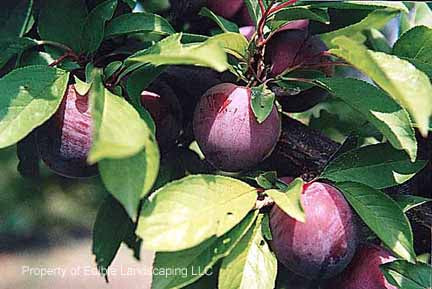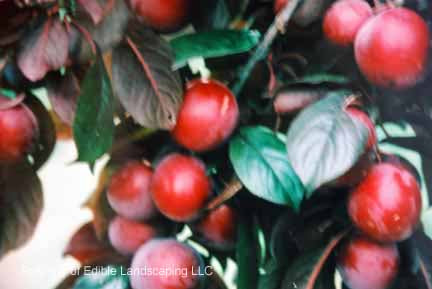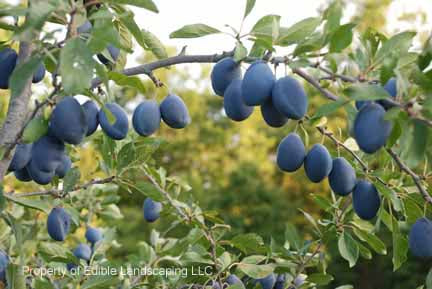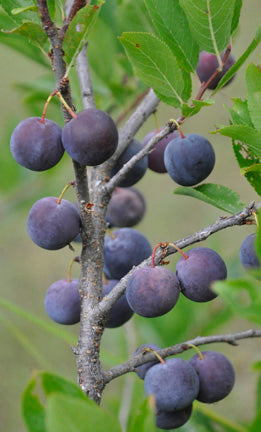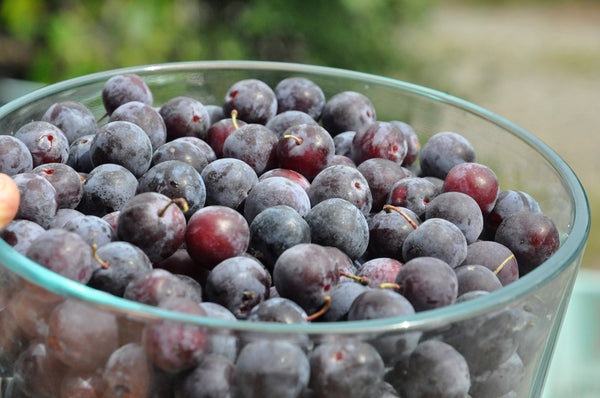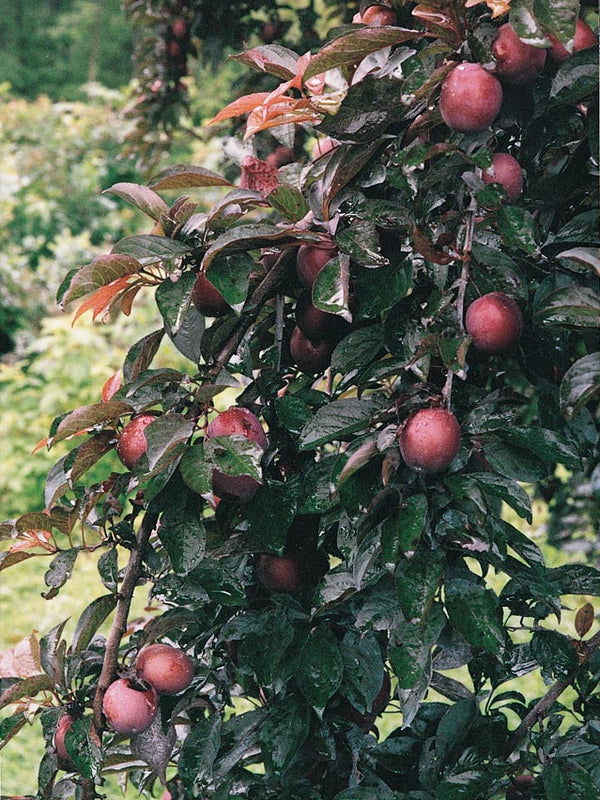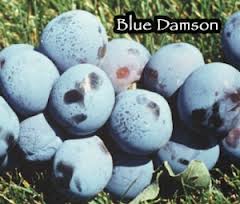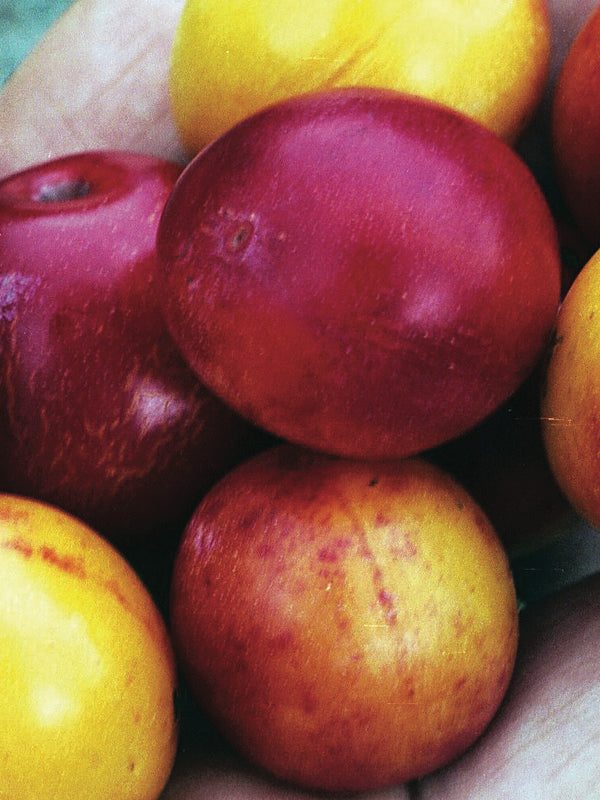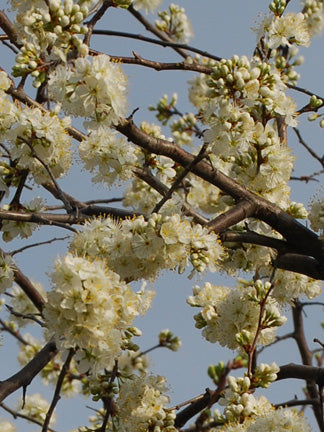Bruce Plum

Prunus salicina X angustifolia
Early fruiting open spreading small tree. A cross between Japanese plum and native Chickasaw. Ripens before Methley. Brown rot resistant. Introduce in 1921 by A. L. Bruce of Donelly County, TX. Zone 6-8.
Due to import restrictions we are unable to ship Plums to CA, WA, Europe...
| Plant Characteristics | |
|---|---|
| Pest Resistance | Very Good |
| Disease Resistance | Very Good |
| Drought Tolerance | Good |
| Heat Tolerance | Very Good |
| Humidity Tolerance | Very Good |
| Sun Tolerance | Very Good |
| Wet Soil Tolerance | Fair |
| Shade Tolerance | Fair |
| No Spray | Fair |
| Salt Tolerance | Fair |
| Fresh for Kids | Very Good |
| Deer Resistance | Fair |
| Thorns | No |
| Plant Type | Tree |
| Soil Type | Adaptable |
| Edible Type | Fruit |
| Self Fertile | No |
| This information is accurate to the best of our knowledge, comments/opinions are always welcome | |
Due to import restrictions Bruce Plum can not be shipped to CA.
Plum Care Guide
Introduction to Plums
Plum trees look great in the yard and can be very showy. A small tree whether the Japanese, European or the native Chickasaw plum occupies a 10' - 15' circle of space in the yard. Japanese plums generally bloom earlier, fruit earlier and have juicy soft textured fruit. They range in colors of purple, black, red and yellow. European plums are generally sweet but dryer with a firm flesh. Prunes come from this type of plum. Also the more tart Damson plum belongs to the European family of plums as do the Gages. European plums range in colors from blue to yellow. The flavor of fresh perfectly ripe plums, especially the Japanese types are not experienced by the casual supermarket goer usually. Their succulent juicy flesh would bruise easily if shipped long distances. Tree ripened they burst with flavor. Picking the fruit is a summertime treat and will become a cherished tradition to look forward to. Native American plums are found in rural areas growing naturally usually in the thickets. The original seedling spreads with new shoots sprouting a few feet from the mother plant. The fruits are small about quarter size and numerous. They range in color from blue to orange or red. Flavor can vary from tart to sweet.
All plums are very ornamental when they flower. When the Japanese plum blooms, the dark dormant brown branches burst their buds to a floral cloud of blossoms, drawing many species of insect pollinators to the tree, even butterflies. Flowering as early as the first week of March they promise warm weather is on its way. After blooming, the showiest varieties are the red leaf varieties such as Hollywood and All Red. Most Purple Leaf plums are sterile and do not fruit. All Red produces an early Japanese type fruit that hides from birds since the red fruits are the same color as the leaves. Hollywood is more of a European type plum, ripening in August with large fruit with firm red flesh.
Choosing a Variety
It's no fun to plant a plum tree only to realize after your long effort that it's not right for your area. Many varieties of plums are introduced for commercial production. The experts who grow these usually live in climates that are very different from ours. Beware of purchasing a plum variety because it looked good at the supermarket.
Choosing the Type
The three best types of plums for our area are Japanese plums, European plums and native plums. Look for Brown Rot resistance in the Japanese and European plums. All Red and Methley are good examples of Japanese plums, also Shiro & Burbank. Stanley is a good choice for European plums. The Gages do best further north.
Stay away from the Plumcots (crosses of apricot and plum) as they bloom way to early. Only the Georgia USDA release Spring Satin works well in our area. It is more plum than apricot. The large black fruit is delicious.
Insects and Diseases
The biggest drawback to successfully growing plums is the female plum curculio. A quarter inch weevil-like insect that deposits an egg on each of 400 fruit before she's done. Which creates a worm in your fruit and premature dropping of the fruit.
Brown Rot - a powdery brown fungus covering the fruit usually just before it ripens. The fungus is air born and spreads easily from fruit to fruit and can destroy the entire crop. Rain and humidity help Brown Rot. Low humidity and sunny weather at ripening time help tremendously.
The best defense against curculio is a smart offense. Know when she comes and for how long. Some trees you can plant and harvest like persimmons, pawpaw, fig, etc. without much effort in between. But at bud break on plums I mix up my clay based deterrent Surround with water and spray my plums. The clay covers the fruit so that the curculio is deterred. She does not like the Surround and doesn't lay her eggs on the fruit. For about four weeks I spray until her egg laying cycle is over. The "clean" (no insect damaged fruit) resists brown rot and my job is done until I start harvesting the fruit.
Consider This
We live in a late frost area. Flowers can bloom in warm sunny weather only to be damaged by a late frost. If you live near a river or creek you may be in a "frost pocket". Lower temperatures on a frosty night are found in these places. It's colder at night in the valleys. The warm air will rise to the hillsides at night and temperatures will vary. A good location may have a low of 33 degrees Fahrenheit while a few miles away near the valley it's 27 degrees. 33 degrees will not hurt the flowers or young fruit, but 27 degrees may. Since the Japanese plums bloom earliest they are most vulnerable. My neighbor hasn't had his favorite Aycock plums for two years because of late frost while I've had two crops at the nursery. He lives two miles away but at a lower elevation.
Planning the Site
If the plum is self fertile and doesn't need another tree for fruit set, you'll need only one spot. The spot will probably have grass. To help change the grass community to a plum community the grass should go. Around a 4-6 foot circle of manipulation or womanipulation will do. Mulching ahead of planting time helps to break down grass or a D-handle digging spade works well and also aerates the soil. Adding top soil is fine. Sprinkling lime, rock phosphate, greensand is fine too. Preparing a bed is similar to what innkeepers do. Welcome your new guest. Remember the new tree will become a member of the family. Planting closer to the house is better than far away. And watering should not be a chore but done effortlessly. Full sun is best and choose a spot where air circulates well. No spraying should be necessary for a few years till your tree starts producing. If you have no other fruits in the yard it may fruit without spray for a few years. Pruning should be minimal, the tress take on a nice shape of their own. In later years keep the center of the tree uncluttered. Lower branching helps the tree have a lower stature so picking is easy from the ground instead of a ladder.
Peal the skin, see it glisten, Now I know what I've been missin.
Written by Michael McConkey for VAGardener.com

